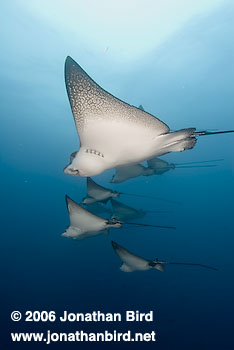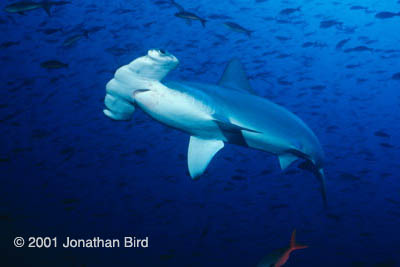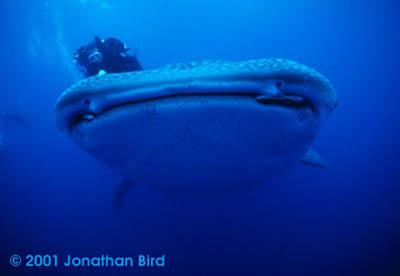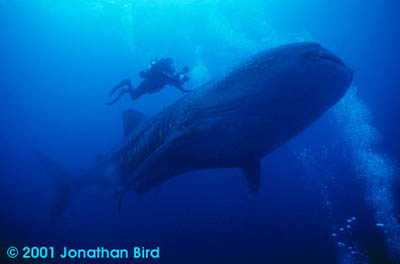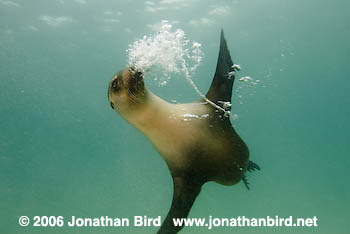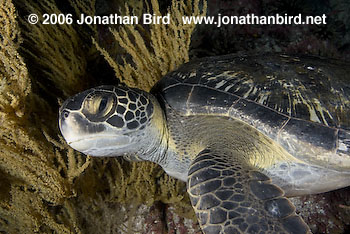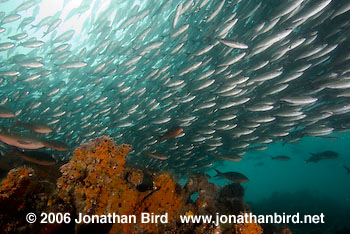
|
DARWIN ISLAND, GALAPAGOS Darwin Island simply has the best "big
animal" diving in the world. No place else
has so much BIG STUFF to see. It is widely
recognized as the whale shark capital of
the world. I have chartered the Aggressor
for a special 12 day itinerary to
Darwin/Wolf Island in August 2009. These
are trips specifically to go to
Darwin/Wolf and stay there for a week to
photograph hammerheads and whale sharks.
Although we can't guarantee anything, we
have never failed to see whale sharks in
the past 5 years. There will be 14 people
on the cruise, including me. Join the fun!
(Check out the 2002
Galapagos Trip Report and the
2003
Trip Report ). By the way, my book Adventures
with Sharks has tons of amazing
images from Darwin Island trips! 2012 trip TBA THIS
IS THE
ULTIMATE
GALAPAGOS TRIP! This trip has been planned during the
height of the whale shark/hammerhead
season. This time of year, Darwin is chock
full of BIG BIG Whale sharks. My previous trips have all been 7 days,
and one thing I have learned is that there
is just not enough time in 7 days to
really experience the Galapagos,
especially because the ride to Wolf and
Darwin islands takes 15 hours. So I
designed this trip to be the ultimate,
with six FULL DAYS at Wolf and Darwin,
instead of 3-4 as in past trips. We visit
some off-the-beaten-path sites for
interesting things like mola mola sunfish,
dives with the penguins and dives with the
marine iguanas. This is a trip designed
specifically for photographers and
videographers who want to shoot all the
unique and exotic things that make the
Galapagos special in ONE TRIP. PRICE: Want to go? CONTACT
JONATHAN Already going or want to see the flight
itinerary? Read
the Darwin FAQ... Basic
Itinerary (please note, this itinerary
is the basic itinerary and may change
slightly as all itineraries can be changed
by the Galapagos National
Park). •Aug
4: Fly to Guayaquil, Ecuador.
Arrive afternoon or evening. •Aug
5: Spend the day in Guayaquil. This
is an important thing to do because bags
are notoriously delayed a day if they miss
a connection. This gives 24 hours for
delayed bags (or people!) to catch up so
we don't have to delay departure of the
boat. Because we are going all the way to
Darwin Island, 15 hours from the main
island group, there will be no way for
late passengers to join us. If you are
late, you will miss the boat! So, plan on
arriving on the 4th and spending a day in
Guayaquil. •Aug
6: Fly to San Christobal,
Galapagos from Guayaquil in the morning.
Board the boat and do a short trip to Isla
Lobos that afternoon. Get in a checkout
dive with the sea lions. •Aug
7: After an overnight run, we wake
up at Wolf Island for 3 dives with
hammerheads and Galapagos sharks, and a
night dive with the Red-lipped
batfish. •Aug
8-12: We dive Darwin
Island for 5 days. This is where we
see huge schools of hammerheads and whale
sharks as well as dolphins, turtles,
massive schools of jacks, etc. •Aug
13: Diving at Roca Redonda
for more large pelagics •Aug
14-15: Diving at Punta Vincente
Roca for mola molas and underwater
shots of marine iguanas. •Aug
16: Snorkeling with the penguins at
Bartolome and land hike. •Aug
17: Disembark boat at San
Cristobal, flights back to Guayaquil.
Overnight in Guayaquil. •Aug 18:
Flights home
from Guayaquil. REQUIREMENTS CONDITIONS
The diving does involve current. The
stronger the current runs, the better the
hammerhead action is. Current can run from
nearly zero to a couple of knots. When the
current is strong, you will need to hold
on to the rocks! But the current doesn't
usually stay strong for a whole dive. It
tends to come and go. Nonetheless, this is
not a trip for a
new or inexperienced diver! Contrary to popular belief, this is not
a deep diving trip. You do not normally
need to dive deep to see the hammerheads
or whale sharks. In fact, you should not
need to dive much deeper than 80 feet if
you don't want to. Rebreathers Other ideas of
prices: Payment
Schedule: Deposit $500.00 Payment 2 $600.00 Payment 3 $1,200.00 Payment 4 $1,800.00 Payment 5 $2,300.00 Please Read
the
Darwin
Trip Info
Page! The Darwin
Trip Info page has the
specifics on flights, dates, etc. PLEASE
read this page before you e-mail me with
questions! Added
Bonus! What camera
gear is best? Digital cameras are great here because
of the instant feedback. Bring a wide
lens! For video, just bring something with a
wide angle lens and the ability to
manually focus or lock the focus. (Auto
focus will not work well on the whale
sharks...they are too big and the
autofocus "hunts" a lot.) GENERAL QUESTIONS on Dive Adventures
with Jonathan Bird? Check out the
General FAQ
page.... More
Dive Adventures with Jonathan
Bird.... Check out the new book Adventures
with Sharks with many images taken
on this trip. A hammerhead
shark passes close by me. With my
15 mm lens, this shark looks like
it's 8 feet from me, but it's
more like 4 feet away, and the
shark is about 7 feet
long. Now
that's a lot of
hammerheads! This shot
gives an idea just how many
hammerheads there are at Darwin
Island. But without continued
protection, these sharks could
all be fished out in a few days.
I'm perched on the rocks at about
70 feet and the sharks pass by
above me in the
hundreds. Another
hammerhead swings in close for a
peek at my Nikonos. When the
hammers are being cleaned, they
come close to the
reef. The mouth
of this shark is six feet across!
Check out a video
clip
of a whale shark from the 2002
trip... |
Last Update 8/19/09

